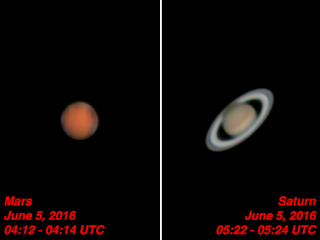Mars and Saturn near opposition

Mars was at opposition (directly opposite the Sun from the Earth) on May 22, and Saturn was at opposition on June 2. I've been itching to get some photos of them, and the combination of clear skies, reasonably good seeing (low upper-atmosphere turbulence) and time available made last night a good choice. Without further ado, the photos: Although the photos say "June 5" I took them the night of June 4, local time, at about 10:12 PM and about 11:22 PM Mountain Daylight Time, from our back yard in Fort Collins, Colorado. My equipment was a Meade LX90 ACF 8" f/10 Schmidt-Cassegrain telescope mounted on an iOptron CEM-60. The camera was a ZWO ASI174MM monochrome camera, with an RGB filter wheel and a 2.4x Barlow, which made the combo a 4800mm focal length f/24 system. Mars was taken with a 1.9ms shutter and a gain of 280 in FireCapture. It was a 640x480 ROI, running at 182 FPS. Saturn was taken with a 6.89ms shutter and a gain of 351, also a 640x480 RO...

